 |
 |
 |
Atsushi Fukui: Gentle Metaphysician
Jeffrey
Ian Rosen |
 |
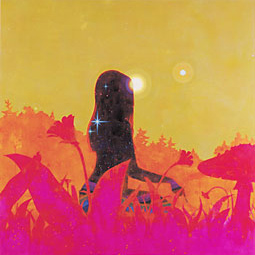 |
 |
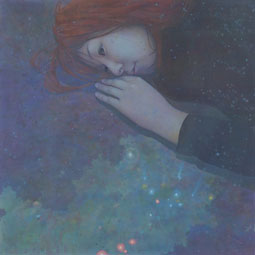 |
Obscure
Drum
Acrylic on canvas, 145.5 x 145.5 cm, 2005
Photo: Keizo Kioku
© Atsushi Fukui
Courtesy of Tomio Koyama Gallery, Tokyo |
 |
The
Great Bear-Cat
Acrylic and ink on canvas, 130.5 x 130.5 cm,
2004
Photo: Yoshitaka Uchida/nomadic studio
© Atsushi Fukui
Courtesy of Tomio Koyama Gallery, Tokyo |
 |
Born in 1966, artist Atsushi Fukui began a professional art career at what would be considered by present-day standards a rather late age: his commercial gallery debut took place in 2001. This slow start -- Fukui graduated from the Tokyo National University of Fine Arts and Music in 1989 -- is evidence of the extent to which sensitivity governs his approach towards art practice, a sensitivity well informed by and deeply rooted in the everyday. Not surprisingly, this approach is mirrored in the artist's paintings and installations. The aforementioned 2001 gallery exhibition was entitled Morning Glory, a group show organized by artist Yoshitomo Nara for the Tokyo exhibition space Tomio Koyama Gallery. Prior to this exhibition, during the 12-year hiatus following Fukui's graduation from art university, he was deeply engaged in the creation of self-produced musical recordings and worked on paintings only for commercial use; he was able to maintain a certain level of professional painting competence while remaining true to his aesthetic interests which were, at that time, drawn to the inward practice of so-called "bedroom recording." Rather than fight against the times, Fukui felt that in 1989 the art world was ill-suited to the temperament of his paintings, he made the decision to focus on his other primary interest, music. Though active creatively as a musician, Fukui paid close attention to developments in contemporary art and at the end of the 1990s, encouraged by the emergence of contemporary painting within Japan as well as Japanese media interest in painting practice abroad -- particularly coverage by the art journal Bijutsu Techo of Scottish painter Peter Doig's 1994 Turner Prize nomination -- he decided that the time was right to begin a creative professional art practice.
 |
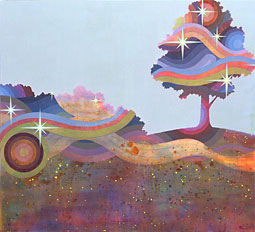 |
Strawberry
Flavored Mushroom
Acrylic on canvas, 91.0 x 100.0 cm, 2004
Photo: Yoshitaka Uchida/nomadic studio
© Atsushi Fukui
Courtesy of Tomio Koyama Gallery, Tokyo |
 |
The paintings comprising Fukui's first mature body of work are characterized by their simplified, graphic forms as well as the artist's restricted palette and disorienting use of scale. Gently metaphysical in nature, these works are meant to prompt a viewer's reconsideration of place. The paintings themselves are self-reflective insofar as they question the painter's point of view; the imagery is rather mundane -- an empty room, sheets of torn paper falling upon a floor -- but the perspective is impossible if considered a direct representation of space as perceived by the artist. Rather, the orientations suggest the possibility of objective, alternative perspectives. That these unfamiliar points of view seem uncannily natural is due, in large part, to the conjunction of rather ordinary subject matter with designed imagery; flatness in color and simplicity of form are conjoined with a shift in perspective to render ordinary space at once extraordinary and surprisingly familiar. This questioning of space was heightened in Fukui's subsequent installation created for the Mori Art Museum's group exhibition Roppongi Crossing (2004), a wide-ranging survey exhibition of contemporary Japanese art practice. For the Mori exhibition, Fukui created a room in which to view his works, all of which were carefully installed with the intent of creating an environment in which the viewer's relation in space to the paintings and drawings directly related to the point of view presented in the works themselves; the depth of the space and an unorthodox hanging height literalized the painted space. In addition, Fukui included sculpture within the installation, thus further bringing painted space into the viewer's world.
It is worth noting Fukui's ongoing collaboration with British musician David Sylvian, as this working relationship has played an important role in the artist's development as a painter. Fukui's early practice as a professional amateur musician carried over in a direct way to the shape of his paintings -- the canvases, usually square, followed an album jacket-cover format and served as covers for non-existing, conceptual albums. In creating artwork to accompany Sylvian's deeply personal 2003 album Blemish as well as the musician's lyric/tour book a fire in the forest (2003), a new, interior world was opened to Fukui. While the more mundane subject matter of his past work remained as a ground, rooms became forests and forms became more complex, sometimes appearing as stills from a non-existing animated fantasy, at other times taking the form of nearly psychedelic landscapes. An element of transparency characterized the new painted work as thin washes of paint and less highly controlled drips contributed to a newly found sense of openness. The musical collaboration marked a return to the interior space of the artist's hiatus -- though, paradoxically, this interior is signified by an exploration of more open and clearly representational space. The resulting paintings reflect a lyrical narrative turn in Fukui's work; this is made explicit in the artist's titles, e.g. the 2004 Koyama Gallery exhibition teenage ghosts (and other scary stories).
The artist is presently at work on a new body of work for a second solo exhibition at Tomio Koyama Gallery. Scheduled to open in October 2006, it will be interesting to see the extent to which Fukui is able to balance his new-found sense of freedom with his original artistic intentions, the result of the artist's inner space externalized.
Note: Jeffrey Ian Rosen would like to extend a sincere "thank you" to the artist, Atsushi Fukui, and Tomio Koyama press representative Tomoko Omori for taking the time to participate in an interview which greatly informed the above text. Atsushi Fukui generously participated in a discussion about his art practice and Tomoko Omori kindly assisted in acting as translator during the more difficult parts of the discussion.
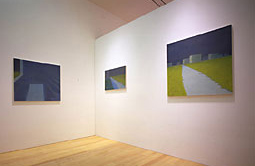 |
 |
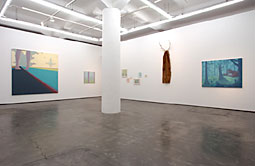 |
Installation
view at Mori Art Museum,
Tokyo 2004
© Atsushi Fukui
Courtesy of Tomio Koyama Gallery, Tokyo |
 |
Installation
view at Tomio Koyama Gallery,
Tokyo 2004
© Atsushi Fukui
Courtesy of Tomio Koyama Gallery, Tokyo |
 |
|
|
 |
|
|
 |
|